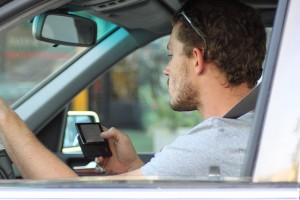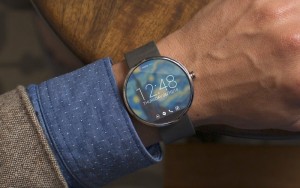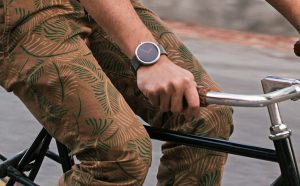We’re all aware of how dangerous smartphones can be when they cause a distraction, especially while driving. That point has been shoved down the public’s throat for years, ever since smartphones became popular. There are plenty of billboards, signs and ads that also warn of such dangers. Sadly, this seemingly excessive exposure is not misplaced.
Texting, or even simply browsing a phone, while driving can be deadly. That’s one of the biggest reasons why voice control platforms like Siri and Google Now exist. It’s also why pretty much every smartphone ever made has some kind of hands-free mode so you can use it while driving yet still pay attention to the road.
 In short, smartphones cause distractions and it can be bad.
In short, smartphones cause distractions and it can be bad.
According to findings from the UK’s Transport Research Laboratory (TRL), smartwatches have the potential to be worse. At first it seems quite foreboding. However, once you stop and consider how smartwatches are meant to be used, it makes a lot of sense.
Are Smartwatches More Dangerous than Phones?
After a wide variety of simulated tests were run, TRL found that drivers using smartwatches have significantly impaired reaction times, simply because they’re focused on another task — interacting with their watch.
 A driver reading text on a smartwatch takes an average of about 2.52 seconds to react. In comparison, it takes 1.85 seconds for a driver using a smartphone to react, and 0.9 seconds for a driver talking to someone else to react. Hopefully, we don’t have to spell out that the slower your reaction time, the more danger you’re in.
A driver reading text on a smartwatch takes an average of about 2.52 seconds to react. In comparison, it takes 1.85 seconds for a driver using a smartphone to react, and 0.9 seconds for a driver talking to someone else to react. Hopefully, we don’t have to spell out that the slower your reaction time, the more danger you’re in.
This is troubling indeed, especially considering legislation on using smartphones while driving is just barely making the rounds. Driving and smartphone use is banned in many countries across the world, with the UK doing so as early as 2003. Unfortunately, only a small handful of US states have outlawed the practice with many repurcussions for doing so being minor in scale.
If the findings of TRL are correct, which logically make sense, then it appears we’ll also need legislation on using smartwatches and wearable devices while driving.
Think about the way you use a smartwatch—notifications, alerts, and messages pop up, tempting you to glance at that tiny screen. Even a brief look can be risky, especially while driving, where seconds matter. A buddy in Tacoma, who’s been testing new features for washington casino sites on his smartwatch to catch live game updates, found himself distracted on the road. Those constant pings, whether checking scores or dismissing alerts, pull your focus from driving, proving why wearable devices can be a real hazard behind the wheel.
That’s exactly why it’s a good rule to ignore any and all electronics — even wearables — while you’re driving. It’s much safer to wait until you’ve parked to mess with a device, than when you’re barreling down the road at 60+ miles per hour.
Driving Isn’t the Only Place Where Smartwatches Are a Safety Hazard
It stands to reason that using these devices while driving won’t be the only problem. For instance, if you’re crossing a road paying attention to your smartwatch instead of your surroundings then you’re more likely to be in an accident. While some of this stuff seems like a no-brainer, you’d be surprised at the number of similar accidents that happen with smartphones alone.
In correlation with the rise of smartphones being used in public, pedestrian deaths have also increased. In 2012, they accounted for nearly 14 percent of US traffic fatalities, which is an increase from 11 percent in 2007.
According to the Metropolitan Washington Council of Governments, the percentage of pedestrian deaths grew from 20 percent in 2004 to 24 percent in 2013 in the Washington region.
 In other words, smartphones can be both distracting and dangerous. This is true no matter where you are, and it doesn’t involve just traffic settings either. While conducting a study on “Distracted Walking,” Jack Nasar — the author — referenced a case where a 14-year-old boy was admitted to a hospital for injuries after falling off an 8 to 6 foot bridge into a ditch. The reason he fell, was because he was distracted by a phone. In another case, a 23-year-old man was struck by a vehicle in the middle of the road, injuring his hip. When he was struck, he was also busy talking on a mobile phone.
In other words, smartphones can be both distracting and dangerous. This is true no matter where you are, and it doesn’t involve just traffic settings either. While conducting a study on “Distracted Walking,” Jack Nasar — the author — referenced a case where a 14-year-old boy was admitted to a hospital for injuries after falling off an 8 to 6 foot bridge into a ditch. The reason he fell, was because he was distracted by a phone. In another case, a 23-year-old man was struck by a vehicle in the middle of the road, injuring his hip. When he was struck, he was also busy talking on a mobile phone.
While most of these cases involve smartphones, it won’t be long before there are some that also include wearable devices and smartwatches. This rule can be applied to any device in the wearable tech market, including fitness trackers.
 Imagine a runner stopping on the side of the road to calibrate their tracker, not paying attention to oncoming traffic. Or, consider a cyclist too busy switching music tracks on his wearable to notice an oncoming vehicle. It’s a recipe for disaster.
Imagine a runner stopping on the side of the road to calibrate their tracker, not paying attention to oncoming traffic. Or, consider a cyclist too busy switching music tracks on his wearable to notice an oncoming vehicle. It’s a recipe for disaster.
This shouldn’t turn you off to using wearables and smartwatches, instead it should just make you more conscientious about how and where you do so. By all means, take advantage of hands-free modes if you feel you absolutely must use these devices while driving. Otherwise, try to refrain from using them at times where you might be too distracted and safety is involved. That includes biking, walking, and driving on open roadways. If you’re going to listen to music, always keep one ear free, and avoid playing with the device often to skip tracks or perform similar actions.
It’s also worth noting there are some manners and forms of etiquette you should be mindful of while using wearables.
